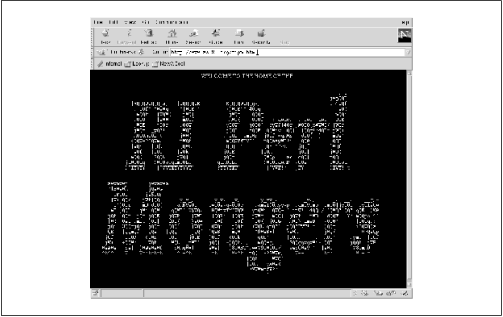ASCII ALTs
The
ALT attribute of an <IMG>
element is used to provide content for browsers that cannot render
graphics. In general, the ALT attribute should
only be used to provide useful information (see the
ALT guidelines in Chapter 2).
In other words, if you have a bunch of little red ball images as
bullets on a page, the ALT text “little red
ball” isn’t exactly helpful. In some circumstances,
however, you may have an image that you would like to have displayed
on both a graphics-capable and a text-only browser. The graphical
browser could simply display the image, and the text browser could
use an alternative representation rendered as
ASCII art. ASCII
art is an esoteric pastime on Usenet and the Web. It is the art of
arranging characters in the ASCII character set to simulate the
shades and nuances of the pixels of an image. Of course, not all
images may be rendered successfully as ASCII art. Photographs in
particular are difficult to identify in ASCII art form unless they
are sufficiently large. Some images translate surprisingly well,
however, particularly very graphic images like logos or other graphic
elements. Figure 10.7 is an example of a web page
that uses ASCII art.

Figure 10-7. ASCII art may be used to sometimes surprising effect on the Web—and it is quick to download
Requirements
| The Gimp |
| AA-Lib |
Solution
Text-only browsers simply plop the ALT text into the document in ...
Get Programming Web Graphics with Perl and GNU Softwar now with the O’Reilly learning platform.
O’Reilly members experience books, live events, courses curated by job role, and more from O’Reilly and nearly 200 top publishers.

